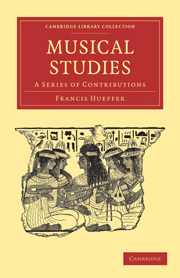Book contents
2 - Gounod's “Polyeucte”
Published online by Cambridge University Press: 29 August 2010
Summary
Monsieur Gounod's new opera, which is shedding its lustre over the closing days of the Exhibition, is not, properly speaking, a work of recent origin. It was commenced several years ago, and its production had been planned more than once. The hackneyed epithet “long expected” may, indeed, be justly applied to the first performance at the Grand Opera, which was given with great éclat on the 7th of October, and was duly recorded in the Times. As to the effect produced by the performance, accounts in French, English, and German papers differ between the extremes of a genuine and lasting impression and a mere noisy succés d'estime, more or less accounted for by the gorgeousness of the scenery. As to the beauty and splendour of this, all judges seem to agree, and Le Figaro especially goes into raptures over antique costumes, triumphal arches, and Sévère's quadriga drawn by four white horses borrowed from the “Administration des Pompes Funèbres.” For, Le Figaro adds, in a fine vein of moral philosophy, “Le cheval ne s'émeut guere de ces brusques transitions dont sa vie est pleine.” With these paraphernalia of operatic splendour we have not to deal on the present occasion. We are concerned with the music alone, and with the music in its naked, unadorned state. Not even the effects of orchestration—the equivalent of colour in the musician's art—can be more than guessed at from the pianoforte score before us.
- Type
- Chapter
- Information
- Musical StudiesA Series of Contributions, pp. 213 - 224Publisher: Cambridge University PressPrint publication year: 2009First published in: 1880



